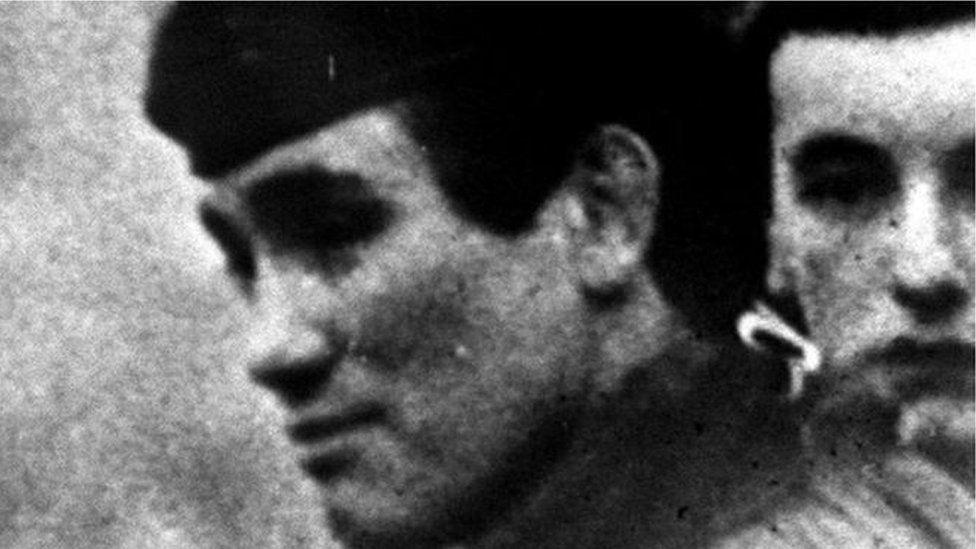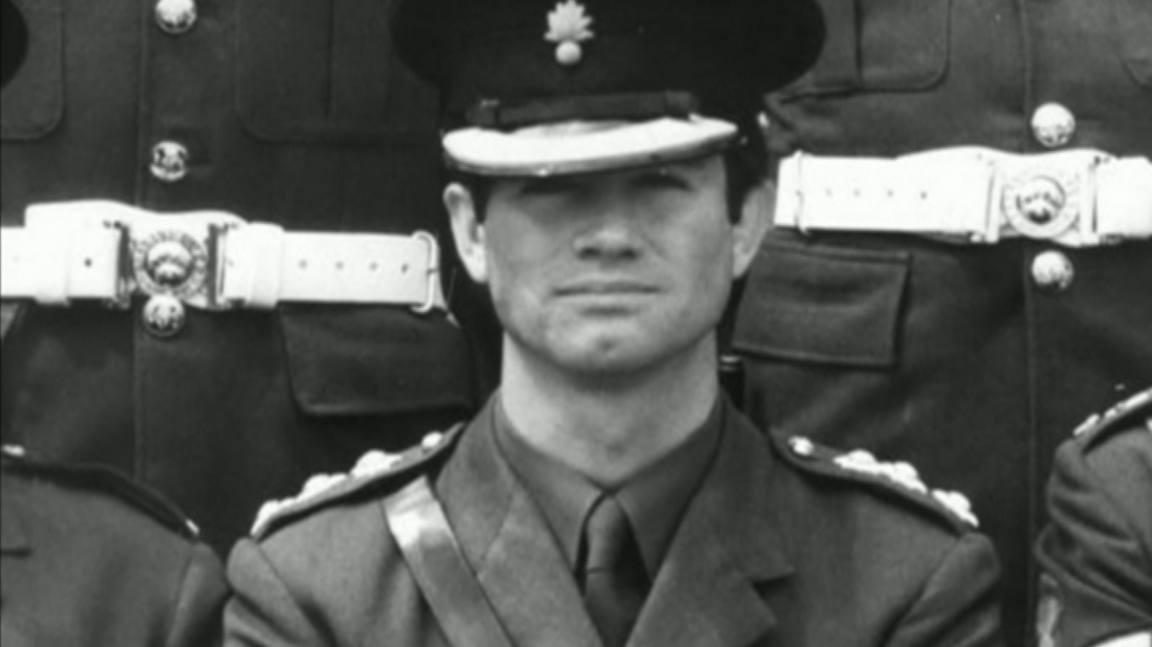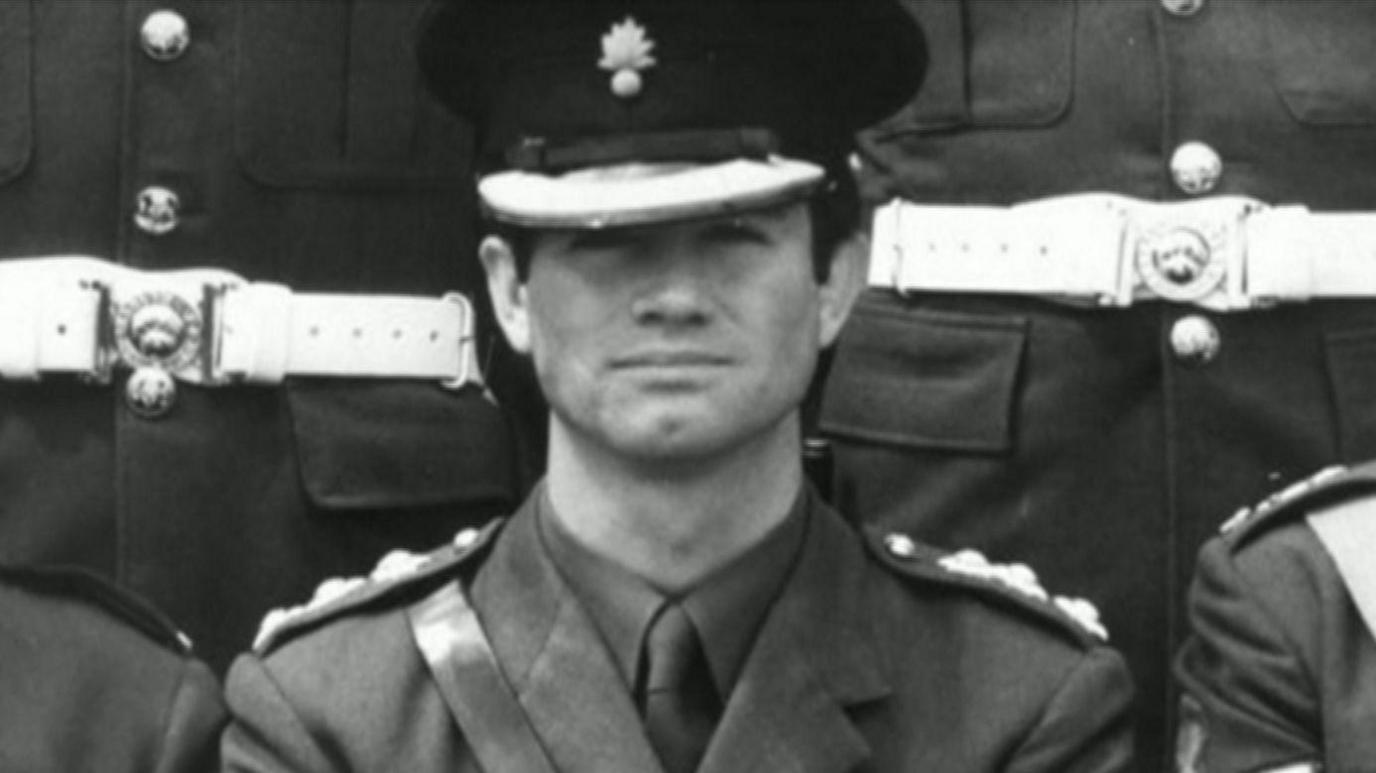Will the mystery around Robert Nairac be solved?

A painting of Capt Nairac - part of the Royal Military Academy (RMA) Sandhurst Collection
- Published
Capt Robert Nairac was one of the most controversial and mysterious figures in the history of The Troubles; a maverick in life, an enigma in death.
On Monday, the organisation charged with trying to find the remains of people murdered and secretly buried by paramilitaries hopes to answer at least one of the questions that have surrounded the soldier's disappearance for decades - what happened to his body?
Over the weekend, the Independent Commission for the Location of Victims' Remains (ICLVR) moved machinery into a field in County Louth close to the border with South Armagh. They will now start digging.
A new BBC podcast tells the story of one man’s three-decade hunt and how it led the commission to this point.
Shot dead at Flurry Bridge

Nairac joined the Grenadier Guards after graduating from Oxford
It was 15 May, 1977.
A man calling himself Danny McErlean walked from the smoke-filled bar of the Three Steps Inn near Dromintee, in south Armagh, into the fresh air of a spring night.
He was hit from behind by a waiting attacker, armed with a fencepost.
Stumbling to the ground, he was set upon by a gang of men who, despite a terrible struggle, managed to subdue him enough to bundle him into a car and away from the pub car park.
McErlean was actually the undercover British Army officer Capt Robert Nairac.
Nairac was never to be seen again.
He was driven to a place called Flurry Bridge in County Louth, where he was badly beaten and shot dead.
What was he doing in the strongly republican pub that night? Had he gone there to meet someone? What led to him being attacked? What happened to his body?
Some of these questions, it seems, will never be answered.
But the ICLVR believes it could be about to answer at least the final one and, in the process, return the officer’s body to his family.
Experts from the commission will start a targeted search on Monday morning.
When they do, they will be acting on information provided by a long-time contact of mine, a former IRA prisoner who has spent almost 30 years trying to find Nairac’s secret burial place.

Captain Robert Nairac was one of 17 people murdered by republicans during the Troubles and secretly buried
Who was Robert Nairac?
Robert Nairac was a devout Catholic from Gloucestershire.
After graduating from Oxford – where he read medieval and military history – he joined the Grenadier Guards.
Nairac’s role in Northern Ireland has always been the subject of debate – and controversy.
The Army has never confirmed that he was in the SAS – and I’m told his name is not on the wall in the regiment’s headquarters in Hereford which commemorates all its dead.
But there has been speculation that he was a member– or at least joined them on numerous secret operations.
Nairac operated in the shadowy and murky world of covert intelligence gathering.
There have been allegations about involvement with loyalist paramilitaries.
Rumours linking him to the Miami Showband massacre and the killing of an IRA commander in County Monaghan persist, but no proof has ever emerged and earlier this year a coroner said suggestions of his involvement in the Kingsmills massacre were “utter fantasy”.
What we do know is that he was a risk-taker and had, at times, an unorthodox approach to soldiering.
Why was Robert Nairac at a south Armagh pub?

The Three Steps Inn in south Armagh
On the night he was abducted and murdered, it is my understanding that Nairac had permission to be at the Three Steps Inn – that his commanding officers at Bessbrook Army base knew he was going to be there – but that he had turned down the suggestion of having troops on the ground to protect him.
However, others who were close to Robert Nairac have said there were soldiers nearby – SAS soldiers.
As he drove to the pub that evening, Capt Nairac who had, apparently, been keeping in touch with Bessbrook Army base by radio, let them know he had reached his destination and then told them he would then be observing radio silence.
However, he was then supposed to click the radio at certain agreed times throughout the evening, but he apparently missed all those times.
We now know he had been abducted.
His initial attackers were not IRA members.
In fact, senior IRA people were furious when they learned what had happened.
This was a wasted opportunity, as far as they were concerned, to have "interrogated" a man with unrivalled knowledge of the security services’ operations in Northern Ireland.
The IRA did claim that they had interrogated Nairac and extracted significant information – they said they’d recovered a Filofax with valuable intelligence – but, as far as I know, that’s not true.
I’ve been told there simply wasn’t enough time between Capt Nairac's abduction and his murder for any such interrogation to have taken place.
What answers, if any, the recovery of his body will provide, we will have to wait and see.
The commission, it seems, is quietly confident that it will find the remains, guided as it has been by my contact.
Why is an ex-IRA prisoner providing information?

Capt Nairac's revolver was recovered
Why has an ex-IRA prisoner spent decades trying to help find the body of a man who would have been regarded as his enemy?
To understand that, we must go back to the early 1970s, to an attack on Crossmaglen security base and to the kindness of another British soldier; this time a Royal Marines Medic.
Shot and severely wounded, my contact thought, one way or another, his life was ending.
“When you’re in a position – where it may cross your mind that you’re going to get executed," he said.
"It’s almost a unique position to be in. Not many people have been in that position.”
Bleeding heavily from his wounds he was convinced he was going to die.
"It had a profound effect on me and to this day, it has a profound effect on me.
“I was shot by Marine Commandos and I expected to be treated as a prisoner of war.
“I wasn't expecting nice things from them, but I knew that I was involved in a war and I said to myself: 'Look it, I'm fighting these people here' - but they came down to me and I was treated badly by them - the squaddies on the ground.
"But out of the corner of my eye I saw one man come towards me and he put his fingers to his lips then to say: 'Just don't say anything and be quiet.'
“He stopped them. I can hear his words yet: 'Leave him alone, leave him alone, he's a soldier.’
"This man was exceptionally kind to me, he saved my life."
After he recovered, my contact was sent back to prison, but he says by the time of his release in 1979 – his time as a paramilitary was over.
He never forgot his experience in Crossmaglen that day.
For almost 30 years he has used his connections to try to find Capt Nairac’s body.
He believes he has done this.
The commission believes so too and the hope is that they will finally bring to an end one of the Troubles’ most enduring mysteries.
Related topics
- Published26 August 2024
